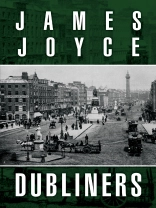A TAPESTRY OF DUBLIN LIFE
James Joyce wrote this collection of fifteen stories in 1914 when he was only twenty-five years old. His first major work,
Dubliners provides a fascinating snapshot of early 20th century life in Ireland, bringing his city to the world for the first time. In these depictions of middle-class life, Joyce portrays ordinary, often defeated people where at least one character in each story has an “epiphany” – a unique moment of realization or illumination.
The rich detail and unshakeable realism of Dublin life highlights those ordinary citizens who are experiencing social decline, sexual exploitation, corruption, personal failure, domestic abuse, or untimely death. With the devastating potato famine still in living memory, Joyce’s unique vision of his native city is one whose inhabitants seem to be paralyzed. In that context, he introduces us to a host of characters including seducers, truants, corrupt politicians, gossips, struggling musicians, sentimental poets, moody adolescents, failing priests, domestic abusers, generous hostesses, rally-drivers, cynical patriots, and people trying to cope and hoping to just get by in life. Many of the characters in these stories later appear in his novel,
Ulysses.
With these fifteen stories the author reinvents the art of fiction, using unflinching realism in order to convey truths that were simultaneously considered both blasphemous and sacred. The collection was decried by some as obscene, but Joyce described the stories as ‘a chapter in the moral history of my country.’
O autorze
James Augustine Aloysius Joyce was an Irish novelist, short story writer, poet, and literary critic. He contributed to the modernist avant-garde movement and is regarded as one of the most influential and important writers of the 20th century.


![Pokrywa Jennifer Richards: Elizabeth Singer [Rowe] Pokrywa Jennifer Richards: Elizabeth Singer [Rowe]](https://static.worldofdigitals.com/thumb_webp/931/9781351940931.webp)









